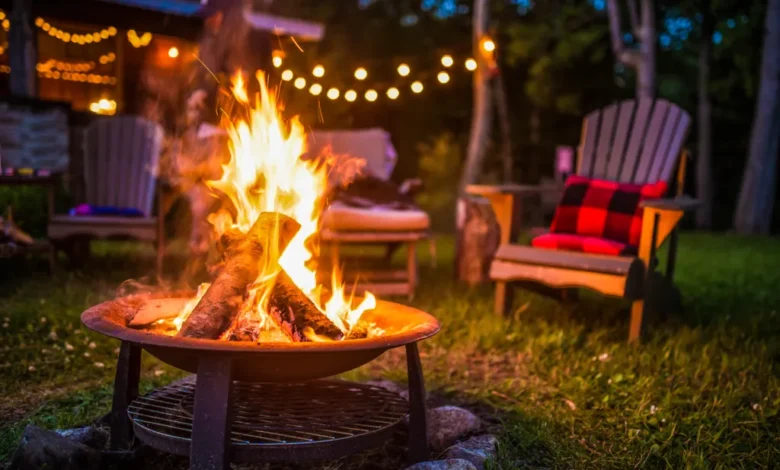The Ultimate Guide to Fire Pits Types, Installation, Maintenance, and Safety Tips

Introduction to Fire Pits
Fire pits have become a beloved feature in outdoor living spaces, bringing both warmth and aesthetic appeal. Their growing popularity can be attributed to their versatility and the ambiance they create, making any backyard or patio more inviting and usable across different seasons. A fire pit can transform an ordinary outdoor area into a cozy, gathering spot for friends and family, extending the use of your outdoor space well beyond daylight hours.
The types of fire pits available in the market today are quite varied, catering to diverse preferences and practical needs. The most traditional option is the wood-burning fire pit, known for its classic feel and the authentic crackling of burning wood. However, gas fire pits, fueled either by natural gas or propane, are becoming increasingly popular due to their convenience and cleaner burn. Electric fire pits offer yet another alternative, providing ease of use with the simple flip of a switch, although they lack the natural elements of fire and wood.
Having a fire pit offers several benefits that enhance outdoor living. One of the primary advantages is the ability to extend your outdoor living space usage well into cooler nights. The warmth emitted from the fire allows for longer evenings outside, whether you’re hosting a gathering or enjoying a quiet night under the stars. Additionally, fire pits serve as a captivating centerpiece, encouraging social interactions and serving as a focal point for conversations and activities. The flickering flames and gentle warmth create a relaxing and welcoming atmosphere, ideal for unwinding with loved ones.
In summary, fire pits provide a myriad of benefits, from practical heating solutions to aesthetic enhancements for your outdoor space. With various types available, including wood-burning, gas, and electric fire pits, there is an option to suit any preference and need. Their continued rise in popularity highlights their integral role in modern outdoor living, melding functionality with style and comfort.
Choosing the Right Fire Pit for Your Space
When choosing the right fire pit for your outdoor space, several key factors should be considered to ensure that your selection meets both your aesthetic and functional needs. The first aspect to evaluate is the size and layout of your space. A small balcony or patio may benefit from a compact, portable fire pit, while a sprawling yard can easily accommodate a larger, built-in model or a fire pit table. The size of your fire pit should ideally complement your space, leaving ample room for seating and maneuverability.
Local building codes and regulations are another crucial consideration. These vary by region, so it’s vital to check with local authorities to understand the rules governing fire pits in your area. Compliance with these regulations ensures safety and helps avoid potential fines or penalties. Additionally, your intended use of the fire pit should guide your decision-making process. Are you looking to provide warmth on chilly evenings, cook meals, or simply enhance your outdoor decor? Each use case might steer you toward a different type of fire pit.
The material of the fire pit plays a significant role in its durability, appearance, and maintenance needs. Steel fire pits are generally affordable, lightweight, and easy to move, but they may rust over time if not properly maintained. Cast iron fire pits, on the other hand, are heavier and more durable, offering better heat retention but can also be prone to rust. Stone fire pits provide a natural and classic look, often requiring less maintenance, but they can be difficult to relocate once installed.
Popular fire pit design styles also offer various benefits and aesthetic appeal. Portable fire pits are typically affordable and flexible, ideal for renters or those who frequently change their outdoor setup. Built-in fire pits become a permanent fixture of your yard, adding significant value and a cohesive design element. Tabletop fire pits are perfect for smaller spaces, offering the ambiance of a fire without taking up too much room. Fire pit tables serve a dual purpose, combining a functional surface with a warming fire feature, making them a versatile addition to your outdoor space.
By considering these factors—space size, local regulations, intended use, and material—you can select a fire pit that not only meets your needs but also enhances your outdoor living experience.
Installation and Setup
Proper installation and setup of a fire pit are critical to ensure safety and enjoyment. The process begins with choosing a suitable location. The site should be level, away from overhanging branches, structures, and flammable materials. Ensure the chosen area has ample ventilation to prevent the accumulation of smoke and harmful gases. A clear space of at least 10 to 20 feet around the fire pit is recommended for safety.
The next step is site preparation. Start by marking the boundaries of the fire pit using spray paint or stakes. Remove any grass, shrubbery, or other organic material within the marked area to create a stable base. Dig down approximately 4 to 6 inches to create a pit. Fill this pit with a layer of gravel or sand to facilitate drainage and improve stability. Compact the base material using a tamper to ensure it is level.
Different types of fire pits have specific installation requirements. For a gas fire pit, run a gas line from your home’s main supply to the fire pit location. This task should be performed by a licensed professional to ensure compliance with local codes. Seal all connections properly to prevent leaks. If you are installing an electric fire pit, an outdoor-rated electrical outlet is needed. Hiring a qualified electrician to set this up enhances safety and reliability.
Enhancing the area around your fire pit can elevate the overall experience. Consider placing comfortable seating arrangements such as outdoor sofas, benches, or stackable chairs. Use durable, weather-resistant cushions and pillows for added comfort. Landscaping can also enhance the aesthetic appeal. Pave the area surrounding the fire pit with stone or brick to create an attractive patio. Adding potted plants and low-maintenance landscaping provides a welcoming atmosphere.
Finally, implement protective measures to prevent fire hazards. Keep a fire extinguisher, a bucket of sand, or a garden hose nearby. Install a spark screen to contain embers and prevent accidental fires. A proper setup ensures your fire pit becomes a safe, attractive centerpiece for outdoor gatherings.
Maintenance and Safety Tips
Maintaining your fire pit in prime condition is pivotal not only for its longevity but also for ensuring safe usage. Each type of fire pit – be it metal, stone, or gas – demands specific cleaning and maintenance practices. For instance, metal fire pits should be routinely scrubbed to eliminate ash and rusting agents, while stone fire pits might require periodic pressure washing to remove soot and residues.
Checking for wear and tear is equally crucial. Examine the structural integrity of your fire pit regularly. For metal fire pits, keep an eye out for signs of rust or corrosion; for stone or brick fire pits, watch for cracks or loose stones that could potentially cause hazards. Gas fire pits require an additional level of maintenance through regular inspections of the gas lines and ignition system, ensuring they are free of obstructions or leaks.
Routine inspections serve as preventive measures. Perform these checks seasonally or after significant usage to stay ahead of potential issues. Additionally, consider utilizing a weather cover when your fire pit is not in use, to shield it from adverse weather conditions which can accelerate wear and deterioration.
When it comes to safety, a cautious approach is necessary. Always keep flammable materials such as paper, leaves, and chemicals at a safe distance from the fire pit to prevent accidental ignitions. Supervision is key – never leave a lit fire unattended, and always keep an eye on children and pets around a fire pit to avoid accidents.
Proper extinguishing of the fire is another vital aspect of safe fire pit use. Ensure the fire is completely doused with water or smothered with sand, and never leave until you are certain there are no remaining embers that might reignite. Having fire safety equipment, such as a fire extinguisher or a bucket of sand, readily accessible near the fire pit can mitigate risks should an emergency arise.
Understanding the emergency procedures and having a contingency plan can be lifesaving. Know your local emergency contact numbers and ensure that everyone using the fire pit is aware of these procedures. A well-maintained fire pit is not only an asset but a safe haven for memorable gatherings.





